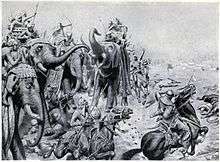Ibrahim Lodi
| Ibrahim Lodhi | |
|---|---|
| Sultan of Delhi | |
 A modern-day Afghan sketch depicting Sultan Ibrahim Lodhi | |
| Reign | 1517– 21 April 1526 |
| Coronation | 1517, Agra |
| Predecessor | Sikandar Lodi |
| Successor | Babur |
| Died |
21 April 1526 Panipat, now Haryana, India |
| Burial | Tehsil Office, Panipat, now Haryana, India |
| House | Lodhi dynasty |
| Father | Sikandar Lodhi |
.jpg)
Ibrahim Lodi (Pashto: ابراهیم لودي, Urdu: ابراہیم لودی;) became the Sultan of Delhi in 1517 after the death of his father Sikandar. He was the last ruler of the Lodhi dynasty, reigning for nine years between 1517 until being defeated and killed at the battle of Panipat by Babur's invading army in 1526, giving way to the emergence of the Mughal Empire in India.[1][2]
Biography
Ibrahim was an ethnic Pashtun. He attained the throne upon the death of his father, Sikandar, but was not blessed with the same ruling capability. He faced a number of rebellions. The Mewar ruler Rana Sangram Singh extended his empire right up to western Uttar Pradesh and threatened to attack Agra. There was rebellion in the East also. Ibrahim Lodi also displeased the nobility when he replaced old and senior commanders by younger ones who were loyal to him. His Afghan nobility eventually invited Babur to invade India. In 1526, the Mughal forces of Babur, the king of Kabulistan (Kabul, Afghanistan), defeated Ibrahim's much larger army in the Battle of Panipat. Ibrahim was killed during the battle. It is estimated that Babur's forces numbered around 25,000–30,000 men and had between 20 and 24 pieces of field artillery. Ibrahim Lodi had around 30,000–40,000 men along with at least 100 elephants . After the end of Lodhi dynasty, the era of Mughal rule commenced .[3]
Tomb
His tomb is often mistaken to be the Shisha Gumbad within Lodi Gardens Delhi. Rather Ibrahim Lodi's Tomb is actually situated near the tehsil office in Panipat, close to the Dargah of Sufi saint Bu Ali Shah Qalandar. It is a simple rectangular structure on a high platform approached by a flight of steps. In 1866, the British relocated the tomb during construction of the Grand Trunk Road and renovated it with an inscription highlighting Ibrahim Lodhi’s death in the Battle of Panipat.[4][5][6]
Gallery
-

An awards ceremony in the Sultan Ibrāhīm’s court before being sent on an expedition to Sambhal
-

1526-First Battle of Panipat, Ibrahim Lodhi and Babur
-

Babur introduced field guns at Panipat in 1526 CE
-
Kabuli Bagh Mosque built by Babur to celebrate his success over Ibrahim Lodhi
See also
- Sher Shah Suri
- First Afghan-Mughal War (1526–1529)
References
- ↑ "SULṬĀN ĪBRAHĪM BIN SULṬĀN SIKANDAR LODHĪ". The Muntakhabu-’rūkh by ‘Abdu-’l-Qādir Ibn-i-Mulūk Shāh, known as Al-Badāoni, translated from the original Persian and edited by George S. A. Ranking, Sir Wolseley Haig and W. H. Lowe. Packard Humanities Institute 1884–1925. Retrieved 2012-11-18.
- ↑ Sen, Sailendra (2013). A Textbook of Medieval Indian History. Primus Books. pp. 122–125. ISBN 978-9-38060-734-4.
- ↑ Davis, Paul K. (1999), 100 Decisive Battles: From Ancient Times to the Present, Oxford University Press, p181.
- ↑ Tomb of Ibrahim Lodi
- ↑ Ibrahim Lodi's Tomb
- ↑ The tale of the missing Lodi tomb The Hindu, Jul 04, 2005.
External links
- Lodī dynasty - Encyclopædia Britannica
- http://www.indohistory.com/lodhi_dynasty.html
- http://www.webindia123.com/history/MEDIEVAL/delhisultanate/delhi%20sultanate4.htm
- http://sify.com/itihaas/fullstory.php?id=13233620
| Regnal titles | ||
|---|---|---|
| Preceded by Sikandar Lodi |
Sultan of Delhi 1517–1526 |
Succeeded by Babur |